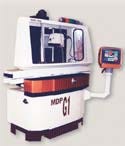May 14, 2004
Originally Published MPMNMay 2004
INDUSTRY NEWS
Machine Uses Electric Current and Abrasives to Grind Materials
MelodyLee
|
A grinding machine that is based on molecular-decomposition process technology can benefit the machining of thin cannulae and other precision instruments. |
It's not the same old grind at Chevalier Machinery Inc. (Santa Fe Springs, CA; www.chevalierusa.com). In partnershipwith another firm, Chevalier has developed a grinding machine that processes all types of conductivemetals. Based on molecular-decomposition process (MDP) technology, the machine uses electric current and abrasives to grind away material. The process is said to be cost-effective,
energy efficient, and fully controllable. It is also pollution free.
MDP involves passing a current through the electrolyte between the positively charged workpiece and
negatively charged abrasive wheel. This causes the metal to soften. The wheel then removes the soft surface of the alloy.
Process monitoring is performed by a controller that uses fuzzy logic and neural network technology. It enables the automation of process optimization, setup presets, electrolyte conductivity, and other tasks that often require user intervention. The closed-loop monitoring system also allows the machine to react to any changes in the preset parameters on the fly. Consequently, heat, stress, and distortion are minimized, even when very thin pieces are being processed.
The controller helps to speed setup by automatically detecting the makeup of the workpiece. The MDP grinder recognizes not only the material but its size, shape, and location. Real-time data on an alloy's decomposition rate is also provided.
The company also notes that modulating the power output based on machining needs has led to dramatic reductions in energy use. Power consumption has been cut by at least 60% compared with other machines,according to the firm.
The grinding wheels are formulated with a copper catalyst. This improves conductivity control andenables tight-tolerance grinding. The resin-bonded wheels can be as thin as 0.020 in. and 0.0005 in. flat. This is advantageous when machining thin cannulae and other precision instruments that require burr-free cutting and slotting.
Environmental concerns have also been addressed. The MDP grinder comes with a treatment system that constantly filters and cleans dirty electrolytes. Suspended solids, metal chips, swarfs, oxides, and residue from the grinding wheel are filtered and deposited in a tank. The materials are then mixed with an electrolyte that converts the liquid waste into small, nontoxic "patties."
Copyright ©2004 Medical Product Manufacturing News
You May Also Like



